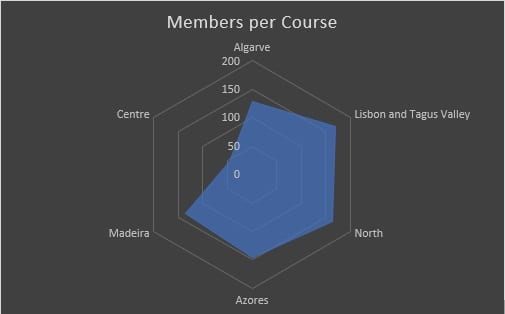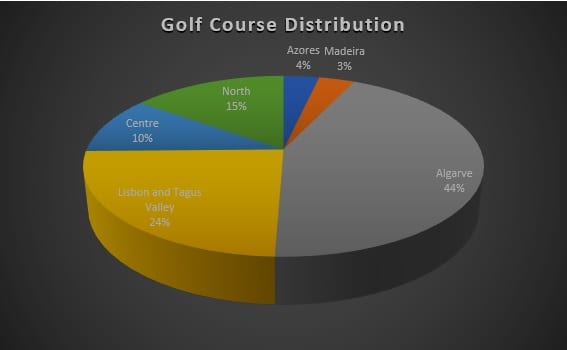With some very isolated exceptions, the sustainability of golf courses has been seriously compromised a little bit all over the world.
The question is: Do we have a few golfers or too many golf courses? Or maybe a bit of both?
In Portugal, especially in the Algarve, despite some tax challenges with the increase of VAT from 6% to 23%, the golf industry is sound and healthy and there are no major concerns.
Portugal, as a golf tourism destination, is on a rise – like any other tourism sector.
On the other end, over the last 15
All of them located in less populated areas and out of the golf tourism rota, meaning they highly depended on members or national golfers.
We all were incapable to understand that the world evolved and so did communities.
The needs and expectations of people had dramatically changed, even beyond what we all thought possible.
Aspects like price, time-consuming and difficulty of the game have been accused of being the main challenges to be surpassed en-route to a healthy and sustainable sport.
I suspect, even though agreeing in principle with the above mentioned, that we are facing a broader issue.
In Portugal there are 168 registered golfers per golf course – average in Europe (countries with 10 or more golf courses) is 555 – which is clearly a very worrying number.

Of the 87 golf courses in Portugal, 44% are in the Algarve and were built with the main, and in most cases solely, the purpose of serving the golf tourism industry.
The concern of developing local golfers hasn’t been a priority for most golf courses, even though there are some cases where local golfer’s development is taken very seriously. Unfortunately, very few.

Golf courses in other areas, like Lisbon, Centre or North of Portugal highly depend on the national golfer, either as a golf club or a golfing society member, the latter being a relatively recent format in Portugal which attracted too many golfers from golf clubs and compromising the sustainability of golf courses.
Portugal has 15.257 registered golfers, of which
- 36,6% are expats,
- 21,2% are golfing society members and
- only 45,4% are Portuguese members of a golf club.

Golf societies: the pros & the cons
Golfing societies offered the possibility of formally participating in the game at a much lower cost.
Other positives of these golfing societies are the opportunity of playing in a varied quantity of courses and not being attached to a single course.
But, of course, there are way too many negative aspects in this equation.
First, this is the most unfair competition between golf clubs and golfing societies, where golf clubs are responsible for maintaining a golfing and social facility at extreme costs and having to compete in terms of selling price with societies which are, in most cases, managed in someone’s existing computer and have literally no costs.
On top of that, golfing societies negotiate very low green fees, that could be as low as €20 per 18 holes.
Surprisingly we haven’t seen a reaction from golf facilities to contradict this situation.
Portugese Golf Federation: golf development innovations
Golf is not like any other sport, by any means, it is the greatest of the games and requires proper facilities to play on and they are expensive to acquire, develop and maintain.
This is more so when we must consider the urban pressure and climate changes – where is golf going to be in 50 years’ time?
This is something federations and international governing bodies are extremely concerned, alongside some stakeholders’ associations and courses but no one else looks minimally thoughtful.
Golf facilities must be equipped with both qualified human resources and equipment in order to respond to those needs and expectations of modern people.
I would highlight three main pillars to transform the way the game of golf is to be presented:
- Quality coaching;
- Human resources: education & qualification;
- Funding golf clubs.
The first aspect has to do with the quality of golf coaching provided, by whom how and where.
We all know that golf, at club level, was miles behind other sports.
The coaches, AKA golf pros, delivered methods totally outdated and the use of technology and respective scientific approach was very limited, to say the least.

In 2018 the Portuguese Golf Federation launched a Golf Academy Certification Program to be implemented by golf clubs and courses throughout Portugal.
A Technical, Marketing and Management Manual was designed to support golf clubs implementing the Certification Program which will also be assisted by a digital Tableau de Bord.
Golf Coaching will be delivered in a structured and sustainable method which will contribute to larger attraction and retention rates.
Secondly, it is of paramount importance to provide education to all those directly or indirectly involved in the game of golf.
An education program is already in place for coaches, managers, referees, golf club staff and greenkeepers.
In this program, we are collaborating with Golf Course Managers Association of Portugal, the Portuguese Greenkeepers Association and the PGA of Portugal.
As matter of fact, working in partnership and in a collaborative way is our mainstream in all matters.
The third pillar addresses one of the major challenges most golf clubs face when trying to do something different – Funding. In this matter, the Portuguese Golf Federation implemented the Golf Development Fund.
This mechanism is funded by a percentage of the PGF licence paid by every golfer and aims to support golf club initiatives related to:
- Grassroot development
- Local community involvement
- Qualification of facilities
- Staff education
- Competitions
In general, to support initiatives that contribute to the sustainability of the game, mainly in areas where golf is less popular.
These initiatives are part of the Strategic Plan 2020 which was developed in conjunction with all national stakeholders and the main goal is to reach the mark of 50.000 registered golfers by 2028.
This growth would clearly contribute to the sustainability of the game, mainly because it would mean an average of 570 registered golfers per golf course in Portugal.
If Portugal doesn’t reach 50.000 registered golfers, it will be inevitable that more and more golf courses will shut down their operations.
This is a purely law of offer and demand.
